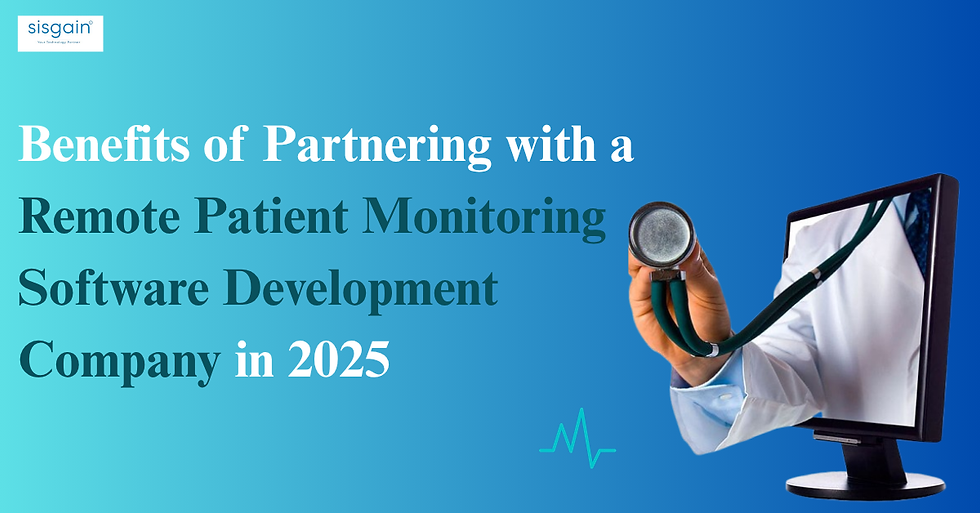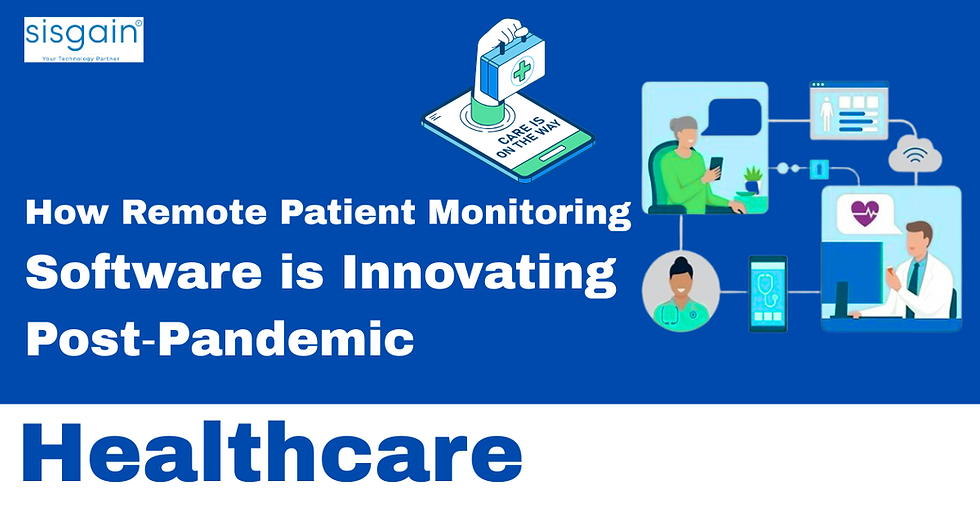How AI-Powered Remote Patient Monitoring Tools Are Transforming Chronic Disease Care in 2025
- sisgainweb20
- 2 days ago
- 5 min read

The year 2025 marks a new era in healthcare innovation. With chronic diseases like diabetes, hypertension, and heart conditions on the rise, healthcare providers are turning to AI-powered remote patient monitoring tools to manage patients more effectively. These remote patient monitoring tools enable continuous care, real-time insights, and data-driven decision-making—bridging the gap between hospitals and home. Through advanced RPM systems, telehealth remote patient monitoring, and AI-based analytics, providers can now predict health risks, personalize treatment, and reduce hospital readmissions.
The Role of AI in Remote Patient Monitoring
Artificial Intelligence has revolutionized how software for remote patient monitoring functions. AI algorithms analyze massive volumes of patient data collected from remote monitoring devices, helping clinicians detect anomalies before they escalate. Instead of waiting for symptoms to worsen, AI alerts doctors in real time—turning traditional reactive healthcare into proactive care.
Modern remote patient monitoring software goes beyond tracking vitals; it learns from patterns. For instance, AI-driven patient management software can flag irregular heartbeats, detect early signs of diabetic complications, or predict hypertensive crises, giving doctors time to act before emergencies occur.
AI-powered remote patient monitoring systems integrate seamlessly with electronic health records (EHRs) and telehealth platforms, ensuring smooth communication between patients, doctors, and caregivers. This integration allows healthcare organizations to create holistic remote patient monitoring solutions that improve patient outcomes and streamline workflows.
How RPM Software Development Has Evolved
The evolution of remote patient monitoring software development has been remarkable. Early systems relied solely on manual data entry, but now RPM software development includes smart sensors, mobile apps, and AI algorithms for automated data analysis.
Today, remote patient monitoring software companies focus on:
Building secure remote patient monitoring apps with encrypted cloud storage.
Developing AI-based dashboards that visualize patient data.
Creating predictive models that identify risk patterns.
Companies investing in remote patient monitoring software development prioritize interoperability, compliance with data regulations (like HIPAA), and scalability. This ensures that remote patient monitoring systems can handle large patient populations without compromising data security.
Furthermore, remote patient monitoring devices such as ECG sensors, glucose monitors, and wearable blood pressure trackers are now AI-enabled, offering real-time data analysis and reporting. As a result, healthcare providers can make data-driven decisions faster and more accurately than ever before.
Chronic Disease Management with AI-Powered RPM Systems
Managing chronic diseases traditionally involved frequent hospital visits, which were costly and time-consuming. However, AI-powered RPM systems have changed this dynamic. Patients can now use remote patient monitoring devices from the comfort of their homes while doctors receive continuous updates through telehealth remote patient monitoring platforms.
Here’s how AI improves chronic disease management:
Predictive Health Insights
AI algorithms in remote patient monitoring software analyze patterns to forecast potential flare-ups or emergencies. This proactive care reduces readmissions and hospital costs.
Personalized Treatment Plans
By studying long-term data trends, AI suggests individualized medication plans, exercise routines, or dietary adjustments.
Real-Time Alerts & Notifications
AI-driven remote patient monitoring tools send instant alerts when readings deviate from normal, allowing doctors to intervene immediately.
Continuous Data Collection
Through smart remote monitoring devices, AI ensures no health data goes unnoticed. Continuous data flow helps identify subtle health changes early.
Improved Patient Engagement
AI-based patient management software provides reminders, motivational feedback, and progress reports, keeping patients more engaged in their care journey.
These advancements are redefining the way chronic conditions are treated, reducing hospital dependency, and ensuring continuous, compassionate care.
The Importance of Telehealth and RPM Integration
The synergy between telehealth remote patient monitoring and AI technology has unlocked new possibilities for healthcare access. Patients living in rural or remote areas can connect with doctors virtually, eliminating geographical barriers. Meanwhile, AI ensures that healthcare professionals have real-time visibility into patient health data.
Telehealth platforms now integrate seamlessly with remote patient monitoring software, offering a unified dashboard that includes:
Patient health records
Real-time vitals from remote patient monitoring devices
AI-generated risk alerts
Communication tools (video calls, chat, and digital prescriptions)
The result is an efficient, patient-centric model that empowers both providers and patients.
Inside an AI-Driven Remote Patient Monitoring System
A comprehensive remote patient monitoring system typically consists of:
Data Collection Devices: Wearables, biosensors, and smart medical devices that continuously capture patient data.
RPM Software: A robust platform that processes data and integrates it with EHRs.
AI Engine: The analytical core that interprets patterns, detects anomalies, and predicts health events.
Telehealth Interface: Allows seamless communication between patients and healthcare professionals.
Dashboard & Reporting: Provides real-time visualizations for clinicians to monitor trends and take timely action.
Remote patient monitoring tools built with AI can also learn and adapt. For instance, if a diabetic patient’s glucose fluctuates often, the AI engine might correlate it with activity levels, diet, or medication adherence and suggest changes.
The Future of RPM Timer & Smart Alerts
An emerging concept in AI-powered remote patient monitoring is the RPM timer—a mechanism that ensures timely check-ins and readings. Instead of relying on manual reminders, AI-driven systems automatically schedule monitoring intervals and adjust frequency based on patient condition.
Example: If a patient’s heart rate pattern becomes erratic, the RPM system can shorten the interval between readings and alert the physician instantly. This intelligent timing reduces response delays and enhances patient safety.
The RPM timer is part of a broader push toward automation in healthcare, ensuring patients receive the right level of attention at the right time.
Market Growth: The Rise of Remote Patient Monitoring Companies
The demand for remote patient monitoring companies and remote patient monitoring software development companies has skyrocketed. Healthcare organizations now seek custom remote patient monitoring app development to meet their unique clinical needs.
Key Trends:
Personalization: Tailoring dashboards and alerts to different chronic diseases.
Interoperability: Ensuring remote patient monitoring systems integrate with hospital EHRs and telehealth platforms.
AI-Driven Analytics: Enabling clinicians to predict complications and optimize treatment.
Data Security: Implementing advanced encryption and compliance with healthcare data laws.
According to market research, the global RPM market is expected to surpass $30 billion by 2025, with AI integration being a primary driver. Leading remote patient monitoring software companies are investing in remote monitoring devices and AI research to enhance accuracy, reliability, and user experience.
Benefits of AI-Powered RPM Tools for Patients & Providers
For Patients:
24/7 access to health insights.
Fewer hospital visits.
Personalized care and continuous feedback.
Enhanced engagement through digital tools and reminders.
For Providers:
Improved decision-making using AI analytics.
Early detection of deteriorating conditions.
Better resource allocation and reduced workload.
Streamlined operations through patient management software integration.
Remote patient monitoring software development companies are focusing on making these systems more intuitive and accessible to both patients and medical professionals.
Data Privacy and Security in Remote Patient Monitoring Software
AI-powered remote patient monitoring tools handle sensitive medical data, making data security a top priority. Leading remote patient monitoring software companies use end-to-end encryption, secure APIs, and blockchain-based systems to protect patient information.
Key measures include:
Role-based access controls.
Regular data audits.
Compliance with healthcare standards like HIPAA and GDPR.
AI-driven threat detection systems.
Secure remote patient monitoring solution development ensures trust between patients, providers, and technology.
Selecting the Right Remote Patient Monitoring Solution
When choosing from the top remote patient monitoring companies, healthcare providers should consider:
Scalability – Can the platform manage a growing patient base?
Interoperability – Does it integrate with EHRs and telehealth systems?
AI Capabilities – Does it offer predictive analytics and real-time alerts?
User Experience – Is it intuitive for patients and clinicians?
Security Standards – Is the remote patient monitoring software HIPAA-compliant?
Working with an experienced remote patient monitoring software development company ensures a smooth implementation and long-term reliability.
Conclusion
As we move further into 2025, AI-powered remote patient monitoring tools will continue transforming chronic disease management, making healthcare more predictive, personalized, and accessible. The fusion of AI, telehealth remote patient monitoring, and smart remote monitoring devices enables a proactive care model that saves lives and reduces costs.
At SISGAIN, a leading remote patient monitoring software development company, we specialize in building advanced remote patient monitoring systems, AI-driven patient management software, and custom telehealth RPM solutions. Our mission is to empower healthcare providers with intelligent, secure, and scalable technologies that redefine how care is delivered.




Comments